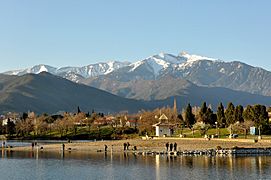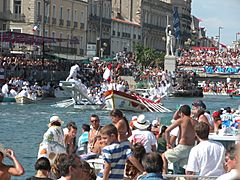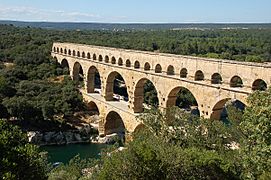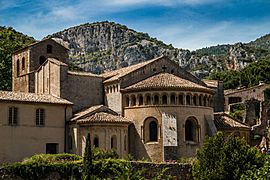Languedoc-Roussillon facts for kids
Quick facts for kids Languedoc-Roussillon |
|||
| Region | |||
|
|||
| Country | |||
|---|---|---|---|
| Préfecture | Montpellier | ||
| - coordinates | 43°36′43″N 3°52′38″E / 43.61194°N 3.87722°E | ||
| Highest point | Pic Carlit | ||
| - elevation | 2,921 m (9,583 ft) | ||
| - coordinates | 42°34′11″N 1°55′55″E / 42.56972°N 1.93194°E | ||
| Area | 27,376 km² (10,570 sq mi) | ||
| Population | 2,700,266 (2012) | ||
| Density | 99 /km² (256 /sq mi) | ||
| Subdivisions | 5 departments 14 arrondissements 186 cantons 1,545 communes |
||
| President | Damien Alary | ||
| Timezone | CET (UTC+1) | ||
| - summer (DST) | CEST (UTC+2) | ||
Languedoc-Roussillon (Occitan: Lengadòc-Rosselhon; Catalan: Llenguadoc-Rosselló) is a former administrative region of France. It is now part of the administrative region of Occitanie. It is the southernmost region of mainland France and borders to the south with Spain and Andorra.
The five departments in the region were Aude, Gard, Hérault, Lozère, and Pyrénées-Orientales.
Its capital was Montpellier, the largest city. In French, the name of the inhabitants of the region is Languedocien-Roussillonnais.
Etymology
The name of the province of Languedoc originates from the language spoken in southern France, langue d'oc, also known as Occitan, and Roussillon, an area in the South of present-day Languedoc-Roussillon.
Geography
The Languedoc-Roussillon region has an area of 27,376 km2 (10,570 sq mi). It bordered to the south with Spain and Andorra; to the east is the Mediterranean Sea (the Gulf of Lion). It also bordered four French regions: Midi-Pyrénées to the west, Auvergne and Rhône-Alpes to the north, and Provence-Alpes-Côte d'Azur (PACA) to the northeast.
The highest point in Languedoc-Roussillon is Pic Carlit (42°34′11″N 01°55′55″E / 42.56972°N 1.93194°E) in the Pyrénées-Orientales department; it is 2,921 m (9,583 ft) high.
Departments
The Languedoc-Roussillon region is formed by five departments:
| Département | Préfecture | ISO 3166-2 |
Population (2012) |
Area (km²) |
Density (Inh./km²) |
|---|---|---|---|---|---|
| Aude | Carcassonne | FR-11 | 362,339 | 6,139 | 59.0 |
| Gard | Nîmes | FR-30 | 725,618 | 5,853 | 124.0 |
| Hérault | Montpellier | FR-34 | 1,077,627 | 6,101 | 176.6 |
| Lozère | Mende | FR-48 | 76,889 | 5,167 | 14.9 |
| Pyrénées-Orientales | Perpignan | FR-66 | 457,793 | 4,116 | 111.2 |
Demographics
The Languedoc-Roussillon region has a population, in 2012, of 2,700,266, for a population density of 98.6 inhabitants/km2.
The 10 most important cities in the region are:
| City | Population (2012) |
Départment |
|---|---|---|
| Montpellier | 268456 | Hérault |
| Nîmes | 146,709 | Gard |
| Perpignan | 120,489 | Pyrénées-Orientales |
| Béziers | 72,970 | Hérault |
| Narbonne | 51,869 | Aude |
| Carcassonne | 47,068 | Aude |
| Sète | 44,558 | Hérault |
| Alès | 41,031 | Gard |
| Lunel | 25,405 | Hérault |
| Agde | 24,651 | Hérault |
Gallery
-
Vinça and the Canigou mountain
-
Les Joutes de la Saint-Louis 2005, Sète
-
Saint-Guilhem-le-Désert abbey
Images for kids
-
Landscape in Lozère, Languedoc-Roussillon
-
Landscape in Aude, Languedoc-Roussillon
-
Pont du Gard aqueduct near Nîmes
See also
 In Spanish: Languedoc-Rosellón para niños
In Spanish: Languedoc-Rosellón para niños












